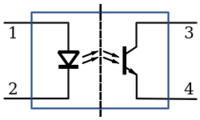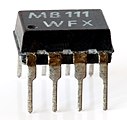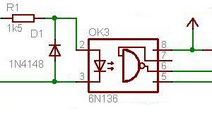Opto-isolated
Summary: An Optoisolator is an electronic device which couples a signal between two circuits optically, electrically isolating both circuits from each other.
Opto-Isolators or Optocouplers
In electronics, an opto-isolator, also called an optocoupler, photocoupler, or optical isolator, is a component that transfers electrical signals between two isolated circuits by using light. Opto-isolators prevent high voltages from affecting the system receiving the signal. Commercially available opto-isolators withstand input-to-output voltages up to 10 kV and voltage transients with speeds up to 10 kV/μs.
The concept is similar to that of a transformer, which through Galvanic Isolation, connects two circuits together while providing isolation. Aside from power supplies, a common application of galvanic isolation is Ethernet connections on a circuit board.
A common type of opto-isolator (or Optocoupler) consists of an LED and a phototransistor in the same opaque package. Usually opto-isolators transfer digital (On-Off) signals, but some techniques allow them to be used with analog signals.
Operation
An opto-isolator connects input and output sides with a beam of light modulated by input current. It transforms the input signal into light, sends it across the dielectric channel, captures light on the output side and transforms it back into electric signal. Unlike transformers, which can pass energy in both directions with low losses, opto-isolators are unidirectional and cannot transmit power. Typical opto-isolators can only modulate the flow of energy already present on the output side. Unlike transformers, opto-isolators can pass DC or slow-moving signals and do not require matching impedances between input and output sides. Both transformers and opto-isolators are effective in breaking ground loops, common in industrial and stage equipment, caused by high or noisy return currents in ground wires.
DCC Applications
Boosters
Boosters with opto-isolated throttle network inputs are available, a typical application would be use with a layout with common rail wiring. This prevents damage from incorrect signals being applied to your booster's input. This is why common rail wiring is discouraged with DCC.
Homemade Decoders
The schematics for a number of homemade DCC decoders often use an optocoupler as part of the circuit which extracts the DCC signal from the incoming power. The DCC track voltages would damage the microcontroller if connected directly. This allows the DCC data to be extracted easily at the voltages needed.




